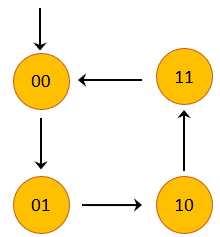Chapter 2: Building Simple Models
2.6 Model Checking
In this section, we will learn how to use Cyclone to perform some model checking that uses elementary operators. Essentially, model checking is a technique that can check whether a transition system meets its defined specification. A specification is typically written in a set of Linear Temporal Logic (LTL)/Computational Tree Logic (CTL) formulas.
Though Cyclone's specification language is different from LTL/CTL formulas, one can use some of its features to express the properties described by LTL/CTL formulas.
2-bit Counter
Let us look at a transition system that captures the states of a 2-bit counter. A 2-bit counter has two bits: left (l) and right (r). In order to move from one state to the next one, our 2-bit counter uses the following transition function R:
R: l'= (l ≠ r) ∧ r'=¬r

¬l ∧ ¬r
Property: G(¬l ∨ ¬ r)
One can use a traditional model checker (such as NuSMV) to check the above property. Since a transition system is really just a graph, Cyclone can also be used for model checking in a very unique way.
Now, let us show you how to use Cyclone to model check this transition system against our property.
First, we define how left and right bit changes based on our transition function in a single state S:
normal start state S {
l = (l!=r);
r = !r;
}
trans t { S -> S }
invariant property { (!l || !r); }
assert ( !initial(l) && !initial(r) );
check for 2,3,4 reach(S)
Alternatively, one can simply just use an assert to express our property instead of an invariant.
assert !(!l || !r);
Note that a smaller bound may unable to reveal a design flaw. In this sense, multiple different larger bounds can be used just like the ones we used. The full specification is available here.
A Transition System
Given a transition system as follows, sometime we would like to find a path such that a set of propositions always hold. In this scenario, we could use always modifier in an assert statement.

In this transition system, L(S0)=L(S3)={a}, L(S1)={a,b} and L(S2)={b}. Suppose we would like check the following property:
Property: there exists a path that a always holds.
assert always ( a );
assert some ( a );
- assert ( a ): Finds a path that leads to a holds. a only needs to hold when a path is terminated/a state is reached.
- assert some ( a ): Finds a path that a holds sometime in a path. Thus, a may not hold when a path is terminated/a state is reached.
@2020-2022 Hao Wu. All rights reserved. Last update: Apr 12, 2022